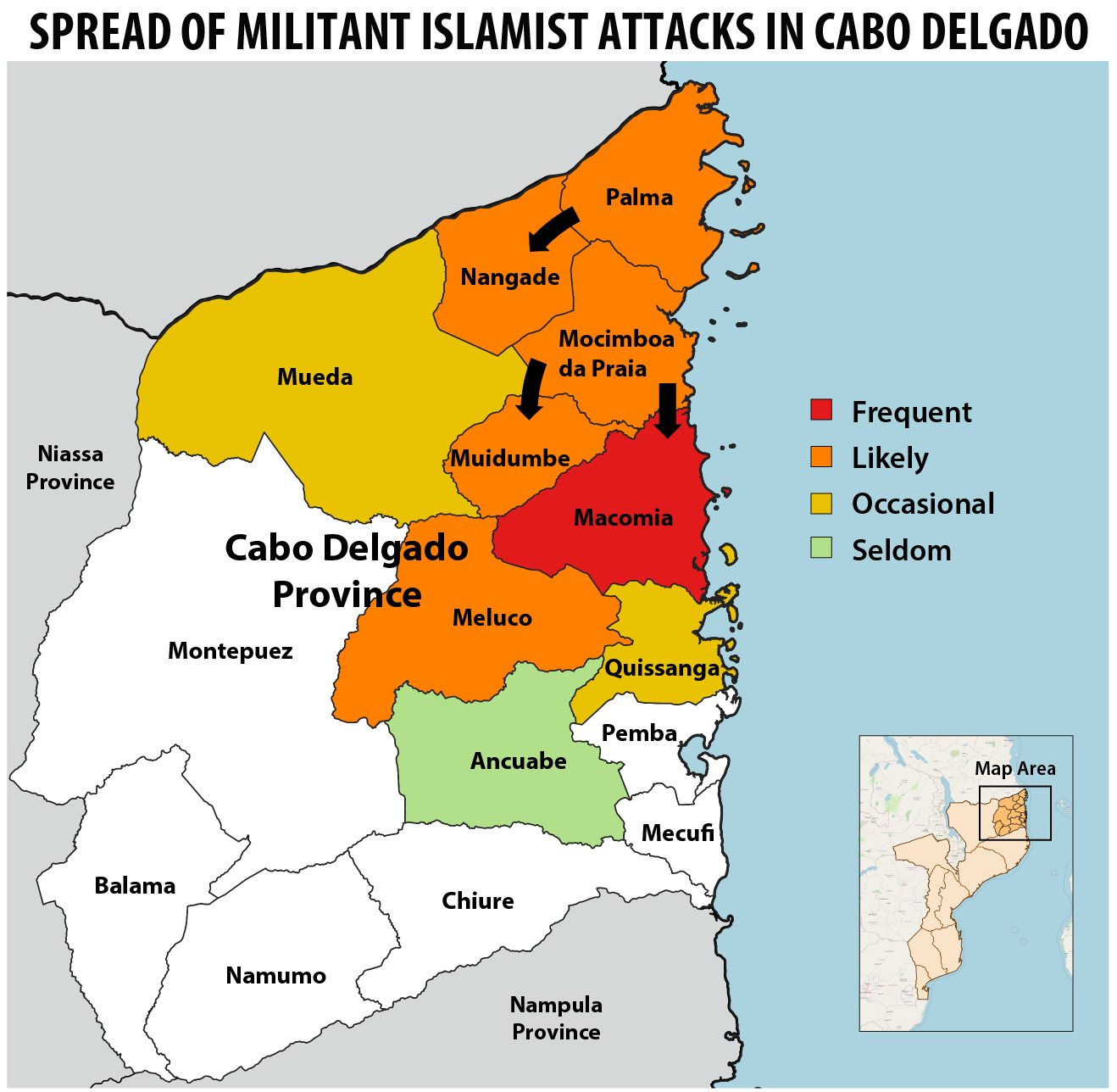Continuing a decade-long upward trend, violent events linked to militant Islamist groups in Africa increased by 22 percent while fatalities surged by 48 percent over the past year.
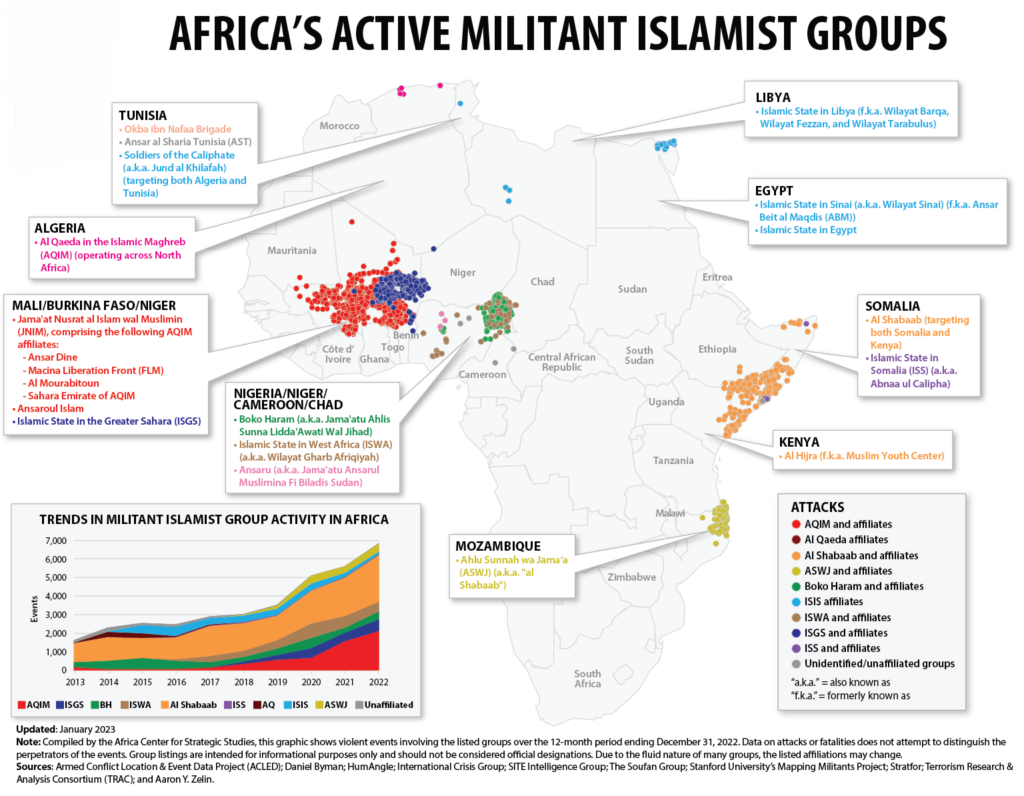
Highlights
- Violence linked to militant Islamist groups in Africa surged by 22 percent over the past year (comprising 6,859 events). This represents a new record of extremist violence and reflects a near doubling in the number of such events since 2019.
Militant Islamist violence in Africa remains concentrated in five theaters, each comprising distinct locally based actors and context-specific challenges—the Sahel, Somalia, Lake Chad Basin, Mozambique, and North Africa. - Militant Islamist Activity by TheaterMilitant Islamist violence in the Sahel and Somalia accounted for 77 percent of the total reported violent events across Africa in 2022.

- Fatalities linked to militant Islamist groups increased an alarming 48 percent over the previous year.
- The estimated 19,109 death toll passes the previous peak of 18,850 fatalities linked to militant Islamists set in 2015 when Boko Haram was at its height. It also marks a sharp reversal from 2021, which saw a slight drop in fatalities—to 12,920.
- The escalation in fatalities is entirely a result of the increased violence in the Sahel and Somalia (accounting for 74 percent of total reported fatalities in Africa) as extremist-linked deaths in the Lake Chad Basin, Mozambique, and North Africa all plateaued or declined over the past year.
- This spike in militant Islamist-linked fatalities was marked by a 68-percent increase in fatalities involving civilians and remote violence (which often targets civilians), underscoring the heavy costs being borne by noncombatants.
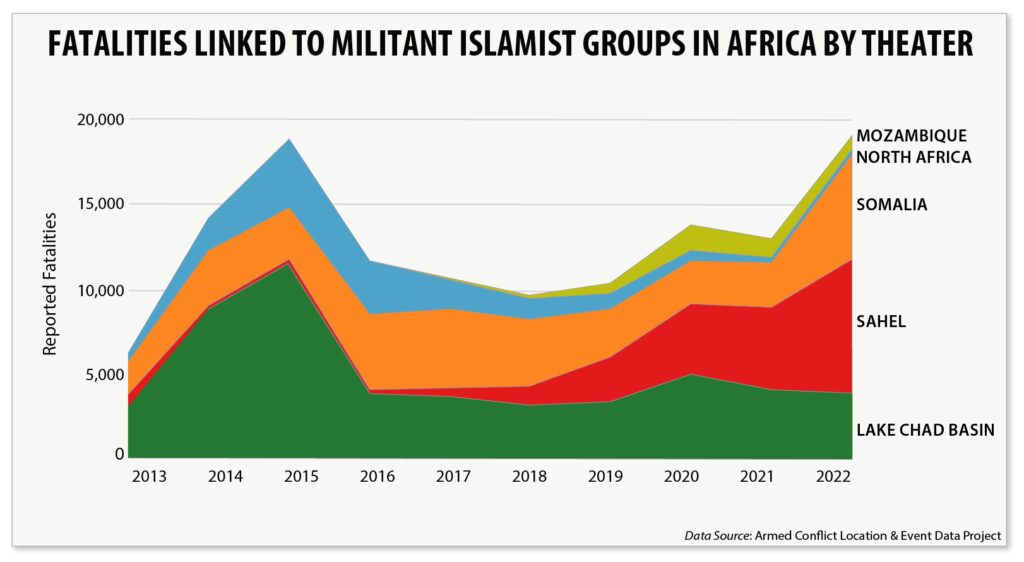
Sahel
- With 2,737 violent events, the western Sahel (Burkina Faso, Mali, and western Niger) experienced the largest escalation in violent events linked to militant Islamists over the past year of any region in Africa, a 36-percent increase.
Fatalities in the Sahel involving militant Islamist groups rose even more rapidly, 63 percent, resulting in 7,899 fatalities. To put this in perspective, the Sahel has experienced a near doubling (90-percent increase) in fatalities and more than a doubling (130-percent increase) in violent events involving militant Islamist groups since 2020.
This timeframe is notable in that it coincides with the seizure of power by a military junta in Mali in August 2020, which justified its coup as needed to address the militant Islamist security threat. However, rather than diminish, the trendline of violence has only accelerated. Moreover, an increasing number of attacks are occurring within 150 km of Bamako. In 2022, the junta demanded the departure of French forces, weakened the mandate of the MINUSMA peacekeeping mission, and brought in the Russian paramilitary force the Wagner Group. - “The Sahel now accounts for 40 percent of all violent activity by militant Islamist groups in Africa, more than any other region in Africa.”
- A similar pattern is unfolding in Burkina Faso where the first of two military coups occurred in January 2022. The country subsequently experienced a 69-percent increase in militant Islamist-linked fatalities over the course of the year, totaling 3,600 deaths.
The Sahel now accounts for 40 percent of all violent activity by militant Islamist groups in Africa, more than any other region in Africa.
The Jama’at Nusrat al Islam wal Muslimin (JNIM) coalition, particularly the Macina Liberation Front (FLM), Ansaroul Islam, and Ansar Dine, were linked to roughly 77 percent of militant Islamist violence and 67 percent of related fatalities in the Sahel. The Islamic State in the Greater Sahara (ISGS) has been tied to the balance. - “There was a 49 percent increase in fatalities from militant Islamist group violence against civilians in the Sahel over the past year”
- There was a startling 49 percent increase in fatalities from militant Islamist group violence against civilians in the Sahel over the past year, involving 978 attacks. The region now accounts for 60 percent of all civilian-targeted fatalities linked to violent extremism in Africa.
The introduction of the Wagner Group into this theater has further escalated violence against civilians in the Sahel. Wagner was linked to 726 reported civilian fatalities compared to the militant Islamists’ 1,984, a ratio of 1:2.7 civilian victims of militant violence.
While 90 percent of all violent events in the Sahel occurred in Burkina Faso and Mali, the past year was also notable for the significant increase in violent episodes in the littoral states. The number of events in Benin jumped from 5 to 37 and in Togo from 1 to 17.
Niger, similarly, saw a 43-percent increase in violent events in the past year, rising to 214. Fatalities were cut in half, however, to 539.
Militant Islamist violence in the Sahel is also responsible for the displacement of more than 2.6 million people. Burkina Faso accounts for the bulk of this displacement, with over 1.8 million displaced.
Somalia
- The most striking trend in Somalia over the past year was the 133-percent increase in the level of fatalities linked to militant Islamist group violence, primarily al Shabaab. There were 6,225 reported deaths tied to al Shabaab in 2022, an increase from 2,606 the previous year. This is a record level of fatalities and exceeds the total of 2020 and 2021 combined.
- Somalia saw a 23-percent increase in violent activity involving al Shabaab over the previous year, totaling 2,553 events. This represents 37 percent of all extremist events in Africa, slightly less than in the Sahel. This marks the first time since 2007 that Somalia did not have the highest annual share of violent events on the continent.
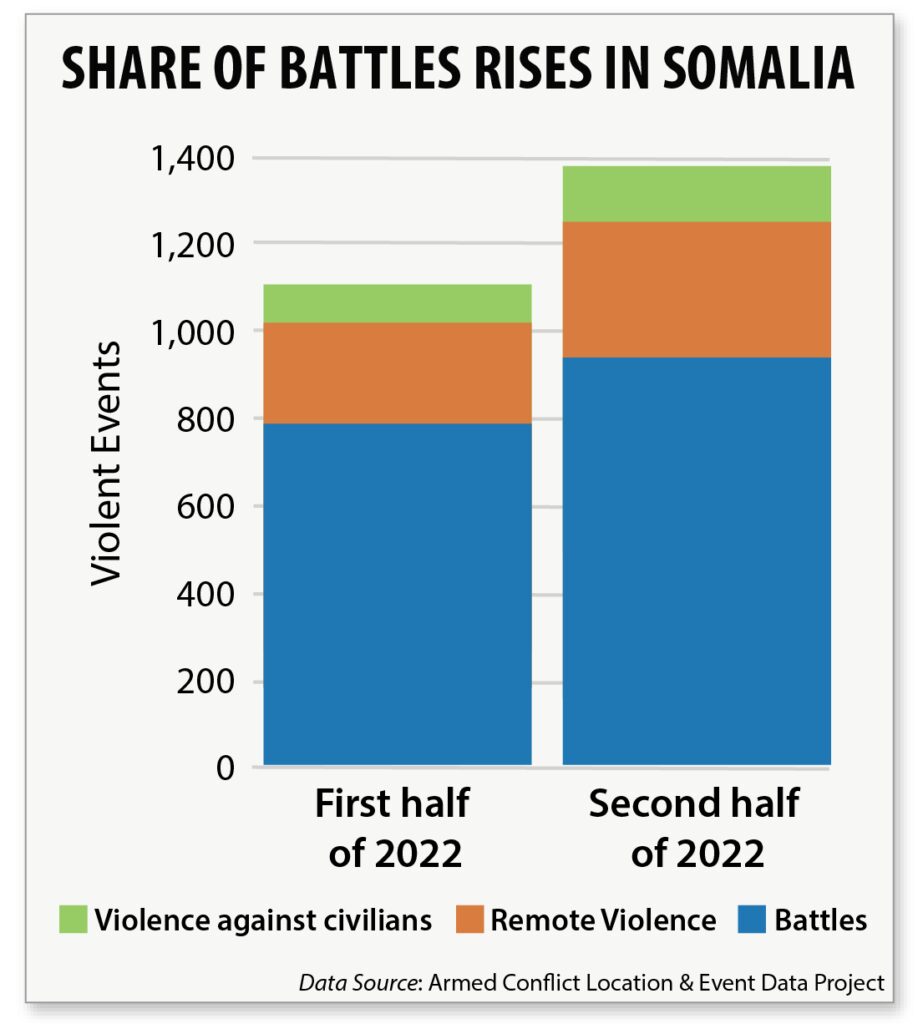
- Somalia was again distinguished by the relatively high percentage of battles, comprising 70 percent of all violence involving al Shabaab. This represents the collective efforts to confront al Shabaab by the Somali National Army, Federal Member State forces, clan militias, and the African Union Transition Mission in Somalia (ATMIS).
- The tempo of battles accelerated in 2022 after the election of President Hassan Sheikh Mohamud in May and his call for an all-out offensive against al Shabaab. This offensive has driven al Shabaab from towns it once controlled, prompting retaliatory attacks. This is reflected in a near 25-percent increase in the number of battles in Somalia—a pace that accelerated in the second half of the year.
- The second half of 2022 also reveals an increase in violence against civilians by al Shabaab (a jump of 41 percent over the first half of the year, from 82 to 116 attacks). This suggests that the offensive has put al Shabaab on the backfoot and it has retaliated by going after soft targets, such as the October twin bombings in Mogadishu that killed over 100 and injured hundreds more.
- The Somalia theater was also marked by a 34-percent increase in IED attacks in the past year and a doubling in the fatalities resulting from IEDs. The UN reported that 613 civilians were killed and 948 injured in 2022, the majority from IEDs laid by al Shabaab. Actions by state security forces, clan militias, and other unidentified actors have also been responsible for civilian casualties.
- Somalia is now experiencing its fifth season of poor rainfall and is expected to see a sixth season of below-average rains in March-June 2023, affecting 8.3 million people. Much of the area facing the most extreme food insecurity, including prospective famine, is in territory that al Shabaab holds or contests. This underscores the challenges of humanitarian access and, at times, outright sabotage of food aid deliveries.
Lake Chad Basin
- Militant Islamist group violence largely plateaued in the past year after a marked 32-percent decrease between 2020 and 2021. The 952 violent events observed in the Lake Chad Basin (straddling four countries: Nigeria, Cameroon, Chad, and southeastern Niger) represent a 4-percent increase in militant Islamist activity from 2021.
The 3,821 fatalities linked to these events, while a 5-percent decline from the previous year, also represent a slowing from the previous year’s 19-percent drop. The Lake Chad Basin remains the third most deadly on the continent, comprising 20 percent of all militant Islamist-linked fatalities.
The past year, meanwhile, saw a 33-percent increase in violence against civilians, causing a doubling in related fatalities (from 299 to 598). This marked a sharp reversal of the almost 50-percent decline in attacks on civilians in 2021. - “The past year, meanwhile, saw a 33-percent increase in violence against civilians, causing a doubling in related fatalities”
- The Lake Chad Basin region also experienced the resurgence of Boko Haram in 2022. Since 2017, Boko Haram had been declining in its relative threat vis-à-vis the breakaway Islamic State in West Africa (ISWA). However, over the past year, Boko Haram was linked to a 57-percent increase in violent events and a 70-percent jump in fatalities. While ISWA continues to be associated with more violence in the region, the levels are now comparable.
These shifts coincide with a geographical spread of attacks outside of Borno State in northeast Nigeria. This past year saw attacks linked to ISWA in Kano, Kogi, Niger, and Taraba States. It was also responsible for a church bombing in Ondo State (South West region), ambitious attacks on a military barracks and a prison outside of Abuja, and an attempted attack on a military barracks near the Benin border in Niger State in the west. Likewise, Boko Haram was linked to violent events in North West Nigeria. Boko Haram and ISWA violence were also linked to relative escalations of violence in Chad and southeastern Niger.
Northern Mozambique
- The number of reported violent incidents linked to militant Islamist groups in northern Mozambique increased by 29 percent in 2022 to 437—a reversal of the 23-percent drop in 2021. Violence is now back to 2020 levels before the intervention of the Southern African Development Community (SADC) and Rwandan forces. Dislodged from the cities of Palma and Mocimboa da Praia along the coast, smaller groups of militants have scattered to the more rural districts west and south, preying on villages—committing killings, beheadings, abductions, looting, and the destruction of property.
- The northern Mozambique theater has always been distinguished by the high levels of violence against civilians. This pattern continues with a further spike in attacks on civilians in the past year (increasing 120 percent to 288 events), reversing a temporary decline in 2021. Similarly, fatalities linked to violence against civilians increased by 57 percent (to 430). Violence against civilians accounts for 66 percent of all violent events in northern Mozambique—more than any other region on the continent.
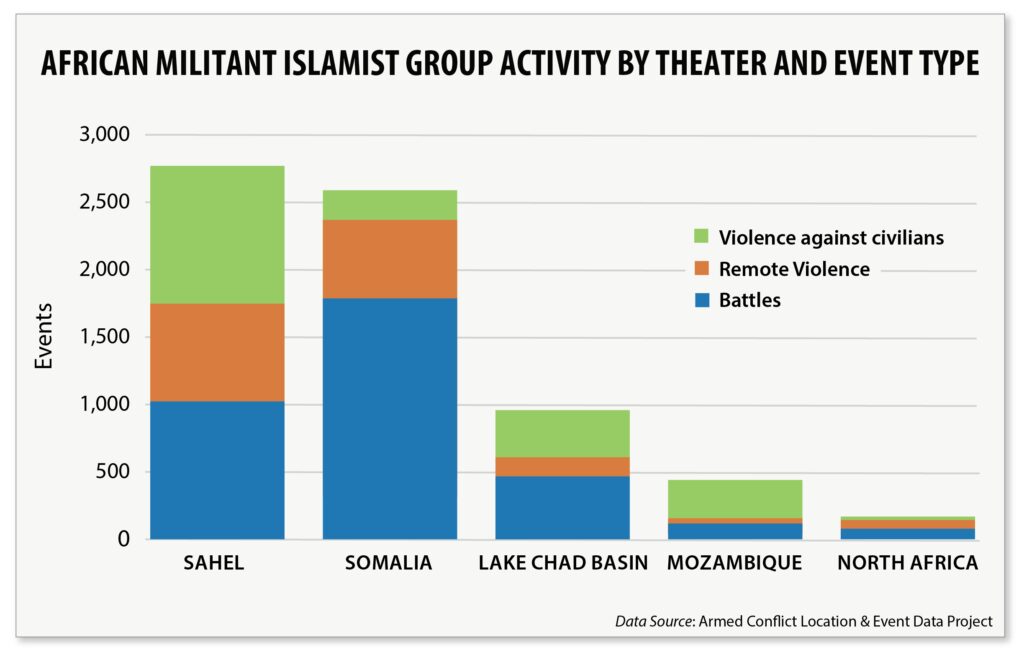
- As a result of this increase and spread of violence against civilians, there are currently more than a million people internally displaced in the four provinces of Cabo Delgado, Niassa, Nampula and Zambézia.
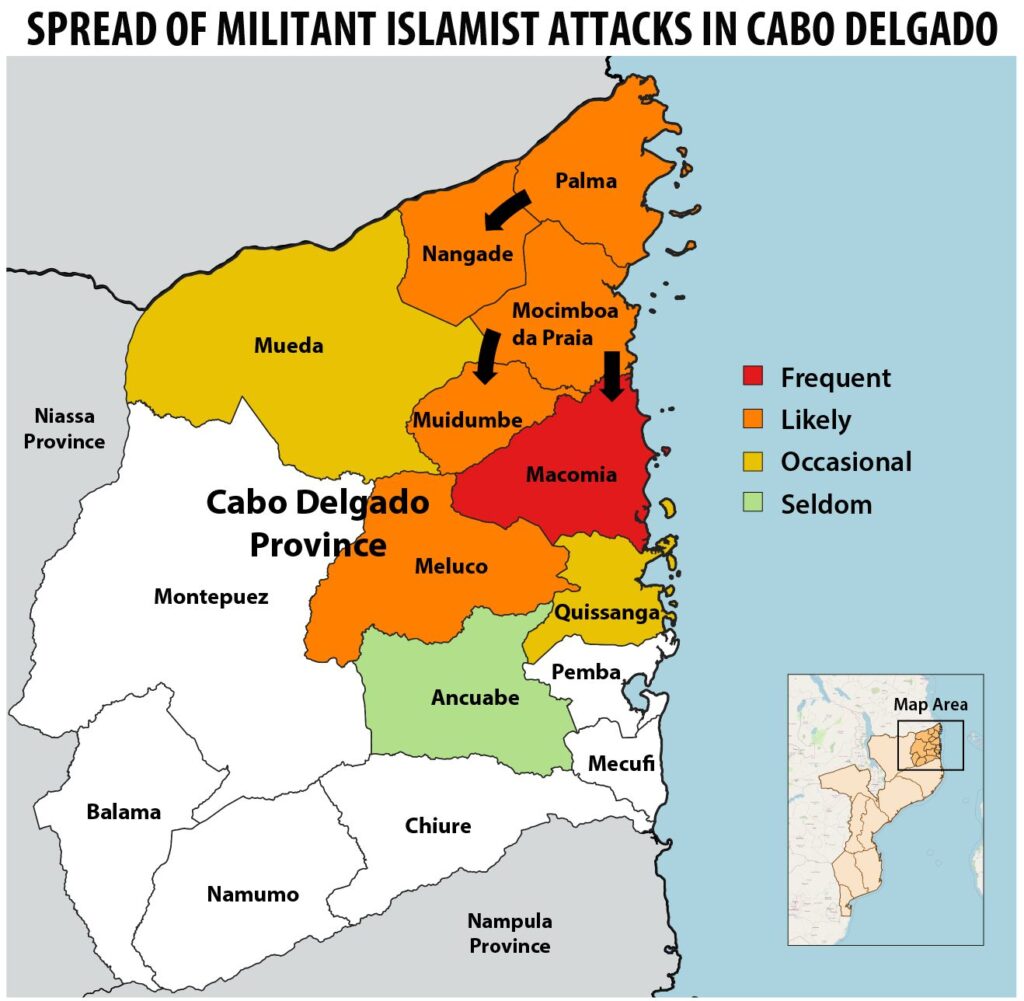
North Africa
- Violent events linked to militant Islamist groups in the North African region dropped by 32 percent over the past year. This continues a steady decline in extremist violence in the region.
- The number of violent events linked to militant Islamist activity is now down to pre-ISIS 2013 levels. The 276 fatalities linked to these events amounts to a 14-fold decline from the over 4,000 fatalities experienced across the North African region in 2015 when ISIS was at its peak.
- Nearly all the reported militant Islamist activity in this region is in Egypt (about 90 percent). The steady decline in violent events coincides with the formation of a union of Sinai tribes joining the fight against ISIS. Though the number of battles in 2022 remained constant, remote violence and violence against civilians dropped (60 percent and 21 percent, respectively).

